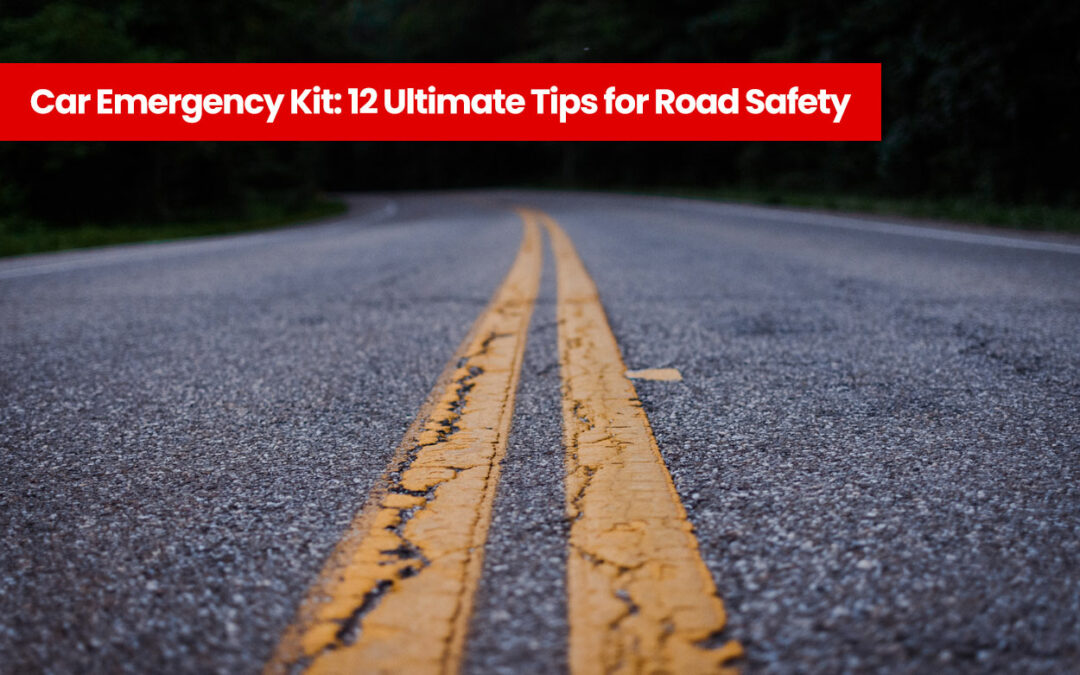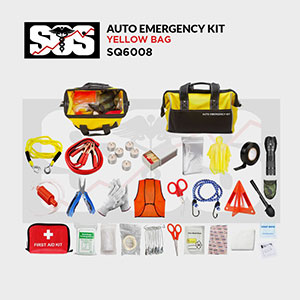The Car Emergency Kit: 12 Ultimate Tips for Road Safety
Situation 1: Flat Tire
We’ve all been there – a sudden lurch, the grind of rubber on asphalt, and the telltale flapping sound. A flat tire is one of the most common road emergencies.
Car Emergency Kit tools to have:
Tire jack, lug wrench, spare tire, tire inflator and sealant.
Preparation tips: Familiarize yourself with your vehicle’s specific process for changing a flat tire. Practice at home so you’ll be comfortable doing it in an emergency situation. Keep the tools in an easy-to-reach place and check the condition of your spare tire regularly.
Situation 2: Dead Battery
Your car’s health often revolves around its battery. Without it, you’re not going anywhere. Batteries can die for many reasons, such as cold weather or simply because they’re old.Car Emergency Kit tools to have:
Jumper cables or a portable battery booster. Preparation tips: Keep your jumper cables clean and untangled. If you’re using a portable battery booster, make sure it’s charged. Learn how to jump-start a car safely to avoid any potential hazards.Situation 3: Overheating Engine
Overheating can be a serious issue, especially during hot summer days. If your engine temperature rises dangerously high, it’s vital to address the problem immediately to avoid damaging your vehicle.
Car Emergency Kit tools to have:
Extra coolant, distilled water, and a funnel.
Preparation tips: Regularly check the coolant level in your car and know how to safely add more if needed. Also, remember never to open a hot radiator cap, as it can lead to serious burns.
Situation 4: Getting Stuck
Whether it’s a muddy backroad after a heavy rain, a snowy embankment in the winter, or a sandy beach, getting your car stuck is a frustrating experience.
Car Emergency Kit tools to have:
Traction mats, shovel, tow rope.
Preparation tips: Know how to use your tools effectively. Placing traction mats under your tires can help you drive out of a sticky situation. A shovel can be handy for digging out tires, and a tow rope is useful if you need another vehicle to pull you out.
A well-prepared car emergency kit is like a good friend – there when you need it, ready to lend a hand in a tough spot.
Our SOS Car Emergency Kit provides you with all of the basic needs for an emergency.
See what’s inside our kit:
Auto Emergency Kit – SQ6008
Situation 5: Running Out of Fuel
It might seem like a no-brainer, but it happens more often than you might think. You’re driving along, not paying attention to your fuel gauge, and suddenly your engine starts to sputter.
Car Emergency Kit tools to have:
Fuel container, roadside assistance membership.
Preparation tips: Always keep your fuel container clean and only use it to carry enough fuel to get you to the nearest station. Regularly check your fuel levels, especially before long trips. And a roadside assistance membership can be a real lifesaver!
Situation 6: Getting Lost
In an age where GPS is ubiquitous, getting lost might seem unlikely. But technology can fail, and there are still places where cell service is spotty at best.
Car Emergency Kit tools to have:
Physical map, compass, printed directions to your destination.
Preparation tips: Learn basic map-reading and compass skills. Keeping printed directions or a physical map as a backup can help you navigate even when technology fails. Ensure you understand your route before embarking on your journey, and consider learning some fundamental orienteering skills.
Situation 7: Bad Weather Conditions
From blizzards to heavy rains, extreme weather conditions can make roads dangerous or impassable.
Car Emergency Kit tools to have:
Ice scraper, snow brush, tire chains, emergency blanket, and a weather radio.
Preparation tips:Regularly check weather forecasts, especially before long trips. Know how to install your tire chains if you’re driving in snowy or icy conditions. Keep your ice scraper and snow brush handy for clearing your windows, and the weather radio can provide critical updates if conditions worsen.
Situation 8: An Accident
Even with the most careful driving, accidents can and do happen. It’s crucial to be prepared to handle the situation safely and responsibly.
Car Emergency Kit tools to have:
First aid kit, flashlight, warning triangles or flares, and a pen and paper.
Preparation tips: Familiarize yourself with basic first aid procedures, and keep your kit stocked and up to date. Use the flashlight to check on passengers and navigate the scene. Set up warning triangles or flares to signal to other drivers and help prevent further accidents. And, of course, you’ll need a pen and paper to exchange information with the other driver(s) and record details of the accident.
Stay safe and prepared on the road. Know before you go!
Here are some helpful links to help you learn about emergency preparedness, weather, road conditions and emergency alerts.
YouTube | SOS Emergency Response Technologies
Drive BC
Emergency Info BC
Winter Driving
Emergency Map BC
Alert Ready
ShakeOut BC
Aside from these car emergency kit specific tools, it’s also smart to keep some all-purpose items in your car. These include water and non-perishable snacks, an extra phone charger, a multi-tool, duct tape, and a blanket. You never know when these might come in handy during a road emergency.
Preparing for emergencies isn’t about anticipating the worst; it’s about equipping yourself with the confidence to face any situation with calm and poise. And remember, the ultimate tool in any emergency is a cool head. No matter what the road throws at you, taking a moment to breathe, assess the situation, and plan your next steps can make all the difference. So stay safe, stay prepared, and enjoy the journey, bumps and all!


